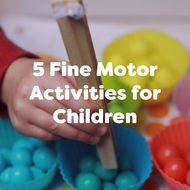5 Fine Motor Activities For EYFS
Posted by EYR Team on 16th May 2022
read more
What are fine motor skills?
Fine motor skills refer to the coordination of small muscles in the brain and nervous system responsible for controlling precise movements in key areas such as hands and fingers.
The development of fine motor skills depends on gross motor skill development. Gross motor skills refer to larger movements such as walking, crawling, and sitting independently. From initial development, children can begin to grasp objects and move small items independently. Infants will then progress onto more complex movements such as weaving and holding cutlery and pencils. Eventually, these movements will develop into writing, getting dressed and eating independently.
The importance of fine motor skills
Fine motor skills are crucial for physical development. Once control and precision are learnt, children can begin to accomplish tasks such as zipping, mark making and manipulating materials. These form part of everyday tasks we take for granted such as cooking, getting dressed and feeding ourselves.
Once children have developed fine motor skills, they can begin to develop their independence in doing a range of tasks. The ability to accomplish everyday tasks will help to improve a child’s self-esteem and confidence to explore the world around them.
Want to learn more about the importance of fine motor activities? Read this useful blog post which covers why fine motor activities are essential in a preschooler's development.
5 EYFS Fine motor activities to try
1. Mark making
Suitable for ages 1-2

Mark making allows children to develop hand-eye coordination and control whilst they dab, scribble and splodge. As they develop their muscles they will progress from paint splotches, to drawing pencil lines and eventually writing.
Not only a foundation for writing, mark making allows children to develop key concentration skills that are necessary for further development and learning.
Mark making can be done with guidance or independently for children to have the opportunity to explore different materials, colours and patterns.
Finally, mark making is a great activity to support other areas of development. Children can talk about what they are painting and what colours they like as they make their creations.
2. Pincer play
Suitable for ages 2-3

Pincer play can be incorporated into many different fine motor activities, all of which will help to strengthen a child’s pincer grip. The pincer grasp refers to the coordination of the thumb and index finger to perform a task and is vital for future development.
Encourage your little ones to practice their pincer grasp with activities such as sand and water play using handy scoopers, pipettes, droppers and scoops. Encourage children to transfer water from one beaker to another using droppers and pipettes. This will focus their efforts on their hands and grip to coordinate the movement.
Another great resource for pincer development is chopsticks! Put your little ones to the test with a chopsticks race. See how quickly children can transfer cotton wool balls from one bowl to another using chopsticks only! These activities will be effective in building strength and muscle memory in children’s hands that will become useful when learning to write.
3. Moulding
Suitable for ages 3-4

Playdough and other malleable materials are very popular with children and can be a great resource to strengthen fine motor skills. Moulding materials is a fun way for children to explore and build up strength in their small muscles and tendons.
It is important to note that many children may be hesitant about touching certain materials. Help your toddler to get more comfortable exploring the new textures by showing them how to poke, squish and play using your hands or tools.
The more they play, the stronger and more capable your little ones will become. Challenge them to create different shapes to explore different hand movements or test them to use one hand and then two.
4. Pre-writing skills
Suitable for ages 4-5

Pre-writing skills are one of the core fine motor skills that children need to develop in order to learn how to write. They are an advance on mark making activities and will help your little one to build strength and movement in their fingers, wrists and grip and improve hand-eye coordination.
Pre-writing skills refer to the patterns and lines that form elements of letters that children can practice to master the correct movements necessary to write.
Pre-writing skills can be practised with little to no resources. Children can trace these lines, strokes and patterns on specialist resources using their fingers or brushes, or they can be easily replicated in materials such as sand, soil, paint or downloadable worksheets!
5. Weaving & threading
Suitable for ages 5-6

Weaving and threading is not only a great way to let your little ones get creative but it is excellent for developing hand-eye coordination, dexterity, concentration and problem-solving skills.
You can encourage your little ones to get involved in weaving either indoors or outdoors and with a variety of different materials. To support further development you could ask your little ones to hunt for natural materials to use in their weaving frames. Leaves and flowers make excellent additions and will encourage further conversations as they hunt for their treasures. Another great resource to help with the development of hand-eye coordination and fine motor skills are lacing cards.
Difficulties with fine motor development
Without fine motor skills, children’s ability to perform tasks will be limited. They may struggle to perform academically or be restricted in play. These can contribute to lower self-esteem. Use these key points to identify if a child has difficulties with fine motor activities at a glance:
- Avoidance of fiddly tasks
- Interest in “passive” activities like watching TV
- Waiting for other to do a task for them such as brushing their teeth or drawing
- Not trying when presented with a challenge and instead asking someone else to do it
- No interest in pencil or scissors skills and activities
For more information about fine motor skills then please refer to the recommended web page from the Government website. An appointment with your GP is recommended if you are concerned about your child’s development.

